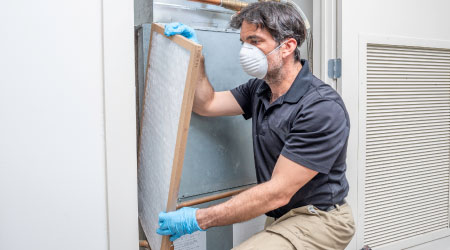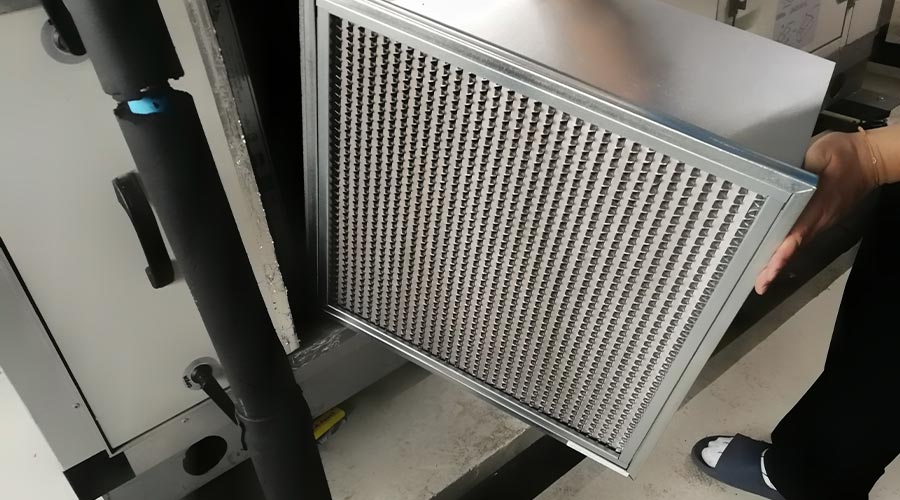RX for Water Systems
An improperly designed water treatment program could be worse than no program at all
When HVAC water circulation systems go unattended, problems can develop rapidly. If these problems are not swiftly detected and corrected, they can cause downtime, reduce operating efficiency and shorten equipment life. Proper water treatment is essential.
Without proper water treatment, both open and closed systems are at risk for three types of problems: corrosion, scale and biological fouling.
- Corrosion is the process of metal dissolution. Uncorrected, it can lead to the loss of system integrity.
- Scale occurs when suspended solids precipitate out and become attached to interior surfaces of piping and heat transfer equipment. Scale can significantly reduce the efficiency and capacity of the entire system.
- Biological fouling occurs when bacteria, fungi and algae grow in the circulating water. Uncorrected, it can foul heat transfer surfaces, plug lines and contribute to corrosion.
A good water treatment program can reduce or eliminate the effects of corrosion, scale and biological fouling. But a program that is not properly designed can be ineffective or cause even more problems. For example, most biocides are corrosive. Applying them in the wrong concentrations or without the proper corrosion inhibitors will worsen corrosion within the system.
Water treatment is much more than simply adding chemicals to HVAC system water. It requires careful planning, a commitment of resources, proper training of maintenance personnel and a focus on safety. Programs that try to skip steps will run into problems. Here are some of the most common problems and ways they can be avoided.
1. Inadequate management support
Unless management makes it a priority, water treatment will not receive the attention of operating and maintenance personnel. Adequate funding is essential, but it’s not the only important factor. Maintenance schedules must also be established and the resources provided to meet those schedules. And record-keeping procedures must be established and monitored.
Responsibility for managing the water treatment program must be assigned to an individual; otherwise, the program will rapidly disappear into the background noise of operations. That individual must then be given the necessary training to establish and run the program. Operators who will be inspecting and testing the systems also must be sufficiently trained.
2. Failing to consider the specifics of the installation
Water treatment programs are not one-size-fits-all. Differences in the type of system being treated, the types of metals found in the system, and the quantity and quality of the makeup water will affect what chemicals should be used as well as their concentrations. The use of the wrong chemicals or the wrong concentrations can make corrosion within the system worse.
The first step in developing a water treatment program is to list the equipment connected to each system. Next, identify the types of metals that are exposed to the water being circulated in the system. Then sample the water being used as makeup water to determine the type and level of contamination present. Finally, determine if there are multiple sources of water used in supplying the system, when it is most likely that each of those sources will be used, and what contaminants are present in each source.
3. Inadequate sampling and testing
Feedback is essential if a water treatment program is to be matched to a specific application. That’s because conditions are constantly changing within the system. For example, the quality of the makeup water can change with the season or if the source of the makeup water is switched. Unless water samples are taken on a regular basis, the program will no longer match the requirements of the application. Treatment costs can become unnecessarily high, treatment effectiveness can be reduced, and equipment can be damaged.
Not only must frequent samples be taken for the program to be effective, but program operators must also take steps to ensure that samples are representative of the actual conditions in the system. Sampling points must not be attached to stagnant sections of pipe. Sample lines and containers must be properly flushed and cleaned before samples are taken. Sampling procedures must match the requirements for the type of test being conducted.
4. Poor record keeping
One of the most important procedures for the long-term effectiveness of the water treatment program is good record keeping. Thoroughly documented logs of test results and actions taken will not only provide a clear indication of the status of the program, but also indicate any trends that are taking place. In the event of a component failure, a review of the records can help identify the cause and what can be done to prevent it happening again. Good records also can help operators to predict the condition of the system components and to identify those that should be inspected.
Typical records that should be kept include:
- Makeup water: quantity used, hardness, conductivity and silica.
- Cooling tower water: pH, hardness, silica, conductivity, and inhibitor and bacterial levels.
- Closed-loop systems: pH, conductivity, iron, hardness, and inhibitor and bacterial levels.
- Chemical treatment: chemical pump settings and dosages.
While these are not the only problems that operators of water treatment programs face, they are the most common. By taking the necessary steps to counteract them, facility executives can help to ensure that their programs are effective in maintaining the efficiency of HVAC water systems while helping ensure the longest possible system and component life.
James Piper is a writer and consultant who has more than 25 years of experience in facilities management. He is a contributing editor to Building Operating Management.
Related Topics:











